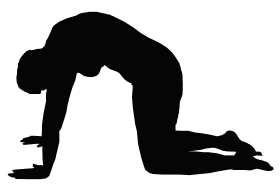There's a reason why yoga is now my favorite form of exercise. It's not JUST exercise - it also has a number of other great benefits - not the least of which is, it's easier on my back than most other forms of exercise, so I can usually keep up with my exercise program even when my back is bothering me. But yoga has some interesting health benefits beyond just helping you get in shape.
|
|
| Cardiac yoga sample exercise (Photo credit: Wikipedia) |
Yoga is a series of postures and positions that originated in ancient India. The word "yoga" means "union" in ancient Sanskrit. The unity refers to the mind, body and spirit being in harmony. The practice of Yoga, which involves the combination of exercise, breathing, and meditation, is said to help harmonize and balance these fundamental aspects of the human being - so it's right in tune with
holistic living.
What Disorders Does Yoga Heal, and How?
According to a Yoga Biomedical Trust survey conducted in the 1980s, Yoga has very real health benefits. Here are some of the problems Yoga is reported to help heal.
*
Asthma - Yoga's focus on slow, deep breathing is extremely helpful for those suffering from asthma. Yoga also relieves the anxiety often associated with asthma attacks. Other respiratory disorders, including bronchitis and emphysema, have also been improved through the practice of Yoga.
*
Hypertension - Because Yoga teaches relaxation and provides regular exercise, it has a positive effect on high blood pressure. There have even been reports of people being able to go off their high blood pressure medication entirely after practicing Yoga.
(Note: Don't do this without consulting your doctor!)
*
Back pain - Unfortunately, back pain is only too common. Yoga can help this greatly. The postures help align the spine, and enhance flexibility and muscle strength. Stress plays a role in back pain, as it increases muscle tension. Yoga's stress-relief techniques address this aspect of back pain, too. Even the breathing exercises of Yoga help back pain through the specific movements of the ribs, chest, and abdomen.
*
General pain - Yoga is said to help the brain deal with pain - it apparently taps into the pain regulating center of the brain and stimulates the secretion of the body's natural pain killers (such as endorphins). Just relaxing muscle tension and meditation - both aspects of Yoga - can help relieve pain, too.
*
Prevention - Yoga promotes self-awareness. Being able to "tap into" your body's signs and signals can go a long way in detecting and preventing illness. Yoga practitioners are said to develop a sense of harmony and unity among the body systems, and when one of these systems is off-balance, a Yoga practitioner is likely to be aware of that imbalance sooner.
*
Depression - Better sleep, improved energy level, and a more positive outlook are all benefits claimed by those who practice Yoga. All of those things help relieve depression.
|
|
| Yoga at Wellspring Vancouver (Photo credit: Wikipedia) |
*
Arthritis - Not surprisingly, this joint-stretching, body-aligning exercise helps relieve arthritis pain. Yoga helps relax muscles and gently increases your joints' range of motion.
*
Thyroid problems - Yoga can have a positive effect on the thyroid, including thyroid cancer. Yoga's "guided imagery" or visualization techniques help sufferers of thyroid disease by stimulating your body's own ability to heal.
While you may not suffer from any of these conditions, and even if you do, there's no guarantee yoga will help cure you, it's also a cheap (or free!) method to try, and it could very well end up helping with some of your symptoms, if not all. It's also a great form of exercise, building endurance, flexibility, strength, lung capacity, bone density, and more. And it can be done almost anywhere, with no equipment but a mat and your own body.
If you haven't tried yoga yet, check out our website for some helpful resources to help you get started discovering the benefits today: http://www.newholisticliving.com/exercise.html























